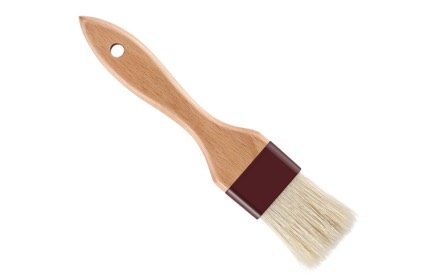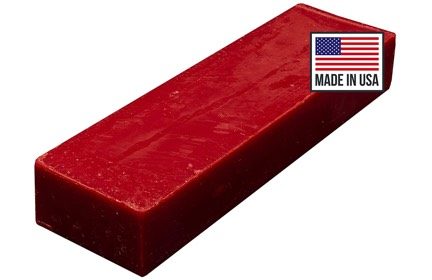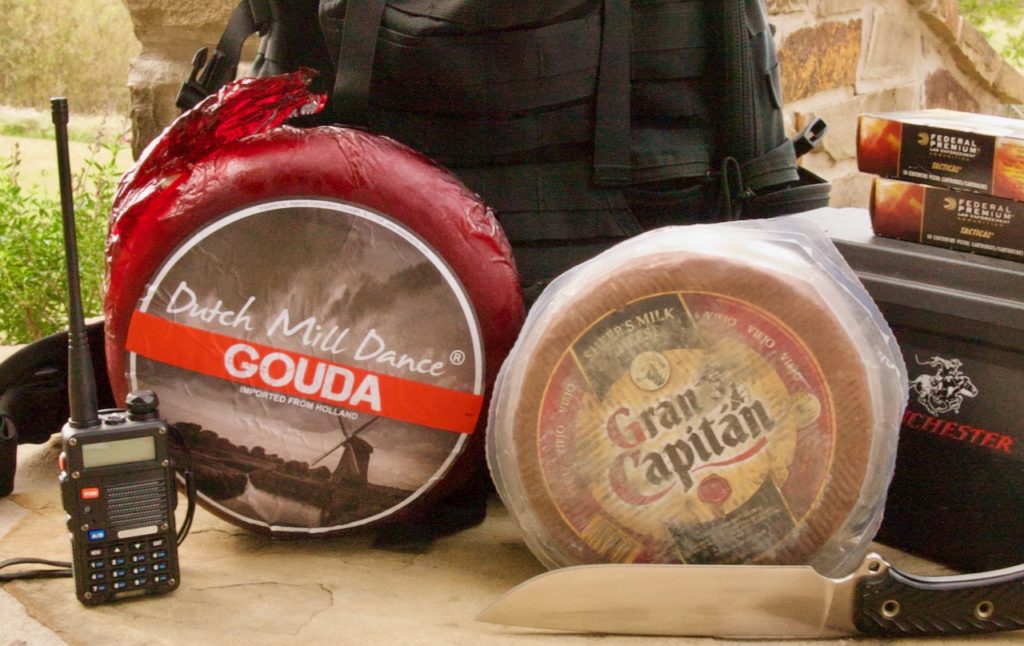Fats and proteins are a bigger challenge when putting together your food preps than other categories like grains and veggies. These critical nutrient families tend to have a terrible shelf life, so if you want either of them in a form that’ll last for years, there are two main options: canned or freeze-dried products like Mountain House.
But what if I told you there’s a food that has the following qualities:
- 28 percent fat (by weight)
- 25 percent protein (by weight)
- No sugar
- Tons of calcium
- Relatively inexpensive in terms of price per ounce of fat and protein
- Vegetarian-friendly
- Always ready to eat, with no preparation required
- Can keep in storage for over 25 years
I’m talking, of course, about the 10-pound gouda waxed cheese wheel in the photo, above. If you buy from a restaurant supply outlet or order it online, this massive (and delicious) chunk of fat and protein will run you about $80. And if you store it right, you can keep it around for decades.
Read more: We taste-tested the popular brands of emergency food in an in-depth review.
I got into the whole cheese-as-a-prep idea back in February, when I randomly hit on the idea of using the impending lockdown as an excuse to realize my life-long dream of owning a full-sized waxed cheese wheel.
One silver lining for me with the impending lockdown, is that I have always wanted an excuse to buy an entire cheese wheel with a waxed rind. This has been a life goal & now I have a reason to make it real. Kinda excited, not gonna lie. pic.twitter.com/j5eGoo1qa0
— Jon Stokes (@jonst0kes) February 29, 2020
But the more I looked into it, the more I realized what an amazingly fat- and protein-rich prep a waxed cheese wheel is, especially when compared to other prepper standbys like canned chili or freeze-dried meals.
Here’s what you need to know:
- A waxed cheese wheel is a vegetarian- and keto-friendly alternative source of long-shelf-life fat and protein.
- If you use part of the wheel (or buy a partial wheel), re-waxing it is cheap and easy.
- Cheese has some finicky storage requirements to get the full shelf life.
- In terms of fat and protein density per ounce, cheese is almost as good as freeze-dried food.
The case for waxed cheese wheels as a prep
An unbroken waxed cheese wheel can last for over 25 years if kept under the right conditions. Indeed, many cheeses are aged in wax for a year or two before even being shipped to customers. Even better, the proper temperature and humidity profile (see below for more on storage needs) can be achieved in a cellar or basement in many parts of the country, so you won’t necessarily need year-round powered refrigeration to store this prep long-term.
You might imagine a massive cheese wheel is hard to actually use as a prep, given that once you cut into it you’ve only got a few weeks of refrigerated life in it before it goes bad. But there’s actually One Cool Trick that totally eliminates this as a problem: just re-wax it.
If you’ve cut off a chunk of your wheel and want to move the rest back into long-term storage, or if you can’t afford a full wheel and want to go with a half or a quarter wheel, you can very easily and inexpensively apply fresh wax to the exposed cheese and re-seal it.

Our pick for most people:
Natural Boar Bristle Basting Brush

Our pick for most people:
Red Cheese Wax 1lb. Block
Unlike many varieties of long-term storage food, cheese is always ready to eat, with no extra prep or special tools needed. Just unwrap it and get after it. In fact, I’m not sure I can think of another type of food that you can take off the shelf where it has sat for 20 years, peel it with your hands, and put it straight into your mouth.
Most varieties of cheese have zero carbs, so they’re extremely keto-friendly. Obviously, even the most committed keto fan will find that sticking to a keto regimen is the last thing they care about in the apocalypse. But if the world doesn’t end and you have to eat your doomsday cheese in the course of normal life, many will appreciate the keto-friendliness of this choice.
Cheese is a great source of calcium, which can be hard to come by in a grid-down. And depending on the variety, there are a number of other vitamins and essential nutrients in a block of cheese.
Finally, cheese can help you regulate your, er, elimination issues. It’s extremely common for sudden changes in diet, like a sudden shift to eating out of cans brought on by doomsday, to cause diarrhea and other gastrointestinal problems. Cheese consumption can help you manage this.
How a waxed cheese wheel compares
Probably the prepper gold standard for a long-term, shelf-stable form of fat and protein is Wolf Brand Chili, the no-beans variety. Wolf Brand Chili is cheap, delicious, and can be had in really large cans that will last for years if taken care of. In fact, if you don’t have a stash of canned chili in your preps, then stop reading this article and run out and buy some before it sells out in the next wave of winter panic shopping.
The other food you’ll find in many preppers’ doomsday stashes is freeze-dried meats and proteins (i.e. eggs). Mountain House is the best, but there are other options, and you can definitely store a ton of fat and protein for decades this way. It’s insanely expensive, though, but more on that in a moment.
For this comparison, I picked the eggs and bacon meal as the most fat- and protein-dense option I could find.
(Note: If you’re vegan, then the doomsday alternative to storing canned meats or waxed cheeses is dying in the first wave of the apocalypse and having your stash raided by the people who prepped appropriately. Sorry, about this. I don’t make the rules.)
Read more: Build your preparedness pantry by following a monthly food plan put together by experts.
So how does a large, waxed cheese wheel stack up to canned chili and freeze-dried packs in terms of price, nutrition, and density of fat and protein? Take a look at this table:
Before we break these numbers down in detail, a word on how I picked the two cheeses for this comparison:
- Dutch gouda: A wheel of Dutch Mill Dance Gouda was what was available at Restaurant Depot when I went, and I don’t recall what I paid for it but it was less than the $100 I’m finding it for on Amazon. I think it was about $80. At about 7g of protein per ounce of cheese, this isn’t the most “prepper” cheese out there but it’s still very good.
- Costco Parmigiano-Regiano Wheel (75lb): Italian Parmigiano-Regiano is the king of prepping cheeses, from a protein, fat, and general nutritional profile perspective. It only comes in very large, very expensive ($950) wheel sizes, so you’ll probably want to either go in with a group or get a partial wheel. If you find good Parmigiano-Regiano wheels in the 10lb range, please let me know in the comments.
I also bought a smaller wheel of sheep’s milk manchego-style cheese, but its nutrient profile is similar enough to the gouda that I didn’t include it in the comparison.
Value
The Wolf Brand Chili pretty soundly beats everything else in the raw value department. If you just want the largest amount of ready-to-eat, long-shelf-life fat and protein for the lowest dollars, then the Wolf Brand Chili No Beans 106oz can is where it’s at, all day long.
The cheeses are in the middle in terms of dollars per gram of fat and protein. The Dutch gouda wheel I bought is competitive with the chili in terms of price per gram of protein, but it’s about two times more expensive in terms of dollars per gram of fat.
All the way at the far end of the value spectrum is the Mountain House Eggs and Bacon meal, an insanely expensive source of long-term fat and protein. This stuff is some ten times more expensive per gram of fat and five times more expensive per gram of protein than the chili, and about 3X to 4X more expensive in both areas than the cheeses.
Winner: chili
Space, weight, and nutrient density
One major downside to the chili is the space required to store it. There’s a lot of liquid in those cans, so they’re just not very energy-dense. This will be an issue for people in apartments or homes with little storage. This space/density issue also makes canned chili a poor choice for an on-foot bugout. It’s strictly a bug-in food option.
The cheeses are excellent in terms of the percentage of their weight that’s made up by fat and protein. In fact, the two cheeses are so good that they’re actually competitive with the Mountain House in this area. No wonder cheese is such a staple of hikers and outdoors types — the fat and protein density is almost as good as the best modern science can do.
Finally, the freeze-dried food does eke out a win in terms of percentage fat and protein per unit weight. It’s a very expensive win, but it is a win. Furthermore, you can compress this stuff down smaller in your pack than you can cheese, so it takes up less volume.
Winner: freeze-dried, but just barely.
Ease of access in an emergency
If you go with the chili then you need a way to get into the can. This isn’t a super difficult task even with no can opener. And as small and cheap as the classic P61 can opener is, there’s no reason not to have a couple of them on your person. Still, the fact that you’ll need some way to get the can open does detract from the convenience.
The cheeses are the most accessible of the foods listed, by far. Just peel and eat. No need for any tools or preparation techniques.
The freeze-dried food options require boiling water to get going, which is a major downside to this category of food prep. In an emergency, you may not always be able to safely boil water, or you might be too tired to hassle with it. You can rehydrate them with cold water in a pinch, but it’s not ideal.
Winner: cheese
Shelf life and ease of storage
Most canned food is widely considered to have three to six years of shelf life. Depending on the type of food and the storage conditions, there will be some changes to taste, texture, and nutritional profile over the years, but it’ll still be edible.
There is, in fact, some scientific evidence that canned food can stay good pretty much indefinitely. Scientists at a food lab once opened up cans of corn and oysters that were decades old and found no real safety problems.
But for safety’s sake, we’re going to stick with the widely cited USDA six-year max for canned goods of any type.
As for ease of storage, you want a place that’s cool (50F to 70F is best, but don’t go above about 80F) and dry (humidity will corrode the cans), which means that most indoor locations that are out of the sun are probably suitable. Cans, then, are very easy to just stash in a closet or pantry and forget about until it’s time to rotate them.
Storing a waxed cheese wheel for decades is, frankly, a project I’m still working on. (This guy is my hero.) I initially threw my two in the fridge and left them there for most of the summer, until I did a bit more homework and realized I should be turning them over periodically (to keep moisture from settling on one side).
My refrigerator’s 40F temperature is a little on the cool side for cheese storage — 45 to 58F is optimal.
I also moved my cheese to the salad drawer of my fridge because the humidity is better. You want north of 80% humidity, depending on the cheese type, to keep them from drying out. I’m actually considering upgrading my cheese storage game with some kind of specialty in-fridge container that also regulates humidity, but that’s a whole other article.
In fact, I may even get really nuts and build my own cheese storage cave out of cinderblocks and earth (it would double as a berm for target practice). I could add a solar-powered mini-split and humidifier for temperature and moisture regulation. This could also function as a fallout shelter. When the bomb drops, we just all rush into the cheese cave and survive on cheese… wouldn’t really even need to add a toilet in there, y’know? My wife hasn’t approved this plan, which is still a work-in-progress, but a man can dream.
The bottom line is that getting the full 25 years of shelf-life out of a waxed cheese wheel requires some research, the right equipment, and regular attention and maintenance. This is way more involved than just tossing some cans in a closet.
As for freeze-dried food, just keep it out of the heat (under 75 degrees) and you can easily get 30 years out of it.
Winner: freeze-dried
Yes, you need a cheese wheel (eventually)
I don’t think a waxed cheese wheel is a first-line food prep — that would probably be the canned chili — but as a backup prep, it’s a fantastic, time-tested option.
In fact, doing this research has basically relieved me of the desire to stock up on more freeze dried food. As a bug-in prep, I think the waxed cheese wheel has the freeze dried options beat hands-down, even with the former’s more complex storage requirements. The freeze dried food is just so expensive that if you can get the fridge space, the cheese wheel is a dramatically better value.
So, once you’ve got your basic food supply squared away, you know what to do — go get your Wallace and Gromit on. I’ll see you in the cheese aisle.


You are reporting the comment """ by on